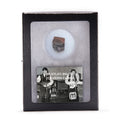Polished Corvettite - SOLD 1.18" Piece



Polished Corvettite - SOLD 1.18" Piece












During the post-war Golden Age of Automobiles, factory workers from several different manufacturers discovered something curious. During the painting process, layers upon layers of automobile paint would accumulate into a layered and beautiful material. When heated and polished, this man-made "motor agate" reveals the colors of the cars that once passed through these factories.
This specimen is a piece of Motor Agate called Corvettite, as it was created from the painting of Corvettes. It measures 1.18" and comes from Chevrolet's St. Louis Truck Assembly and dates to the 1970s.

Motor Agate Treasure
Each piece of Corvettite is a whirlwind of color, the end result of thousands of layers of automobile paint accumulating.
This Corvettite material comes from the historic St. Louis Truck Assembly. It dates to the 1970s, when hundreds of classic Chevrolet Corvettes were rolling off the line for General Motors.
Drop by drop, each layer represents a different vehicle as it passed through the paint booth in the factory. Heated to hundreds of degrees, the layers fused together to form one of the most beautiful and completely accidental man-made composites.

📸 A sample piece of Corvettite in hand
This specimen is a refined piece of Corvettite, which has been cut and smoothed to show the beautiful colors and patterns of the material. Each specimen is completely unique and no two are the same.
Each specimen ships in a hinged black padded box and comes complete with an informational card that serves as certificate of authenticity. Every piece has been photographed and listed individually by size. You can explore the complete collection below!
Want to see more automobile history? Check out Fordite Pendants too! Each is made from paint at the Ford River Rouge Complex in Dearborn, Michigan.

MORE ABOUT CORVETTITE

Layers of Paint and History
The earliest cars were painted by hand, often using brushes or by dipping parts in slow-drying varnishes. By some accounts it took days to dry car bodies, and manufacturers like Henry Ford took to pre-making thousands of car bodies in advance and storing them on floors built above the assembly line.
By the 1920s, advances in paint technology allowed the industry to move to spray guns and faster drying nitrocellulose lacquers. It was during this time that most cars began undergoing heat treatment to bond the lacquer to the metal and to help the paint dry even faster.

📸 1968 AD FOR THE CORVETTE (C3)
By the 1940s, thousands of vehicles were moving through the factories of each automotive company, where they were sprayed and painted much faster than before. A side effect of this was the buildup of dripping paint from overspray on the assembly line rails, which had to be chipped away every so often. The colors of the time were darker and more muted, but the swirling patterns were all there. Later, during the 1950s and 1960s when acrylic lacquers had taken over, the so called "motor agate" appeared in bright metallic colors.
In the 1970s, auto manufacturers began moving to electrostatic bonding of paint to cut down on waste and to reduce the environmental impact of volatile organic compounds. The introduction of industrial paint robots also cut down on the amount of Corvettite and similar "motor agates" produced by the automotive industry, but, despite rumors to the contrary, "new" material can still be found.
Today, over 90,000,000 cars and trucks are produced around the world each and every year. That's more than 170 vehicles a minute. Two cars were produced while you read the last two sentences. And no matter where on Earth they are assembled, each and every one needs to be painted.

📸 ST. LOUIS TRUCK ASSEMBLY PLANT IN 1946
THE HOME OF CORVETTITE
Our Corvettite material comes from the St. Louis Truck Assembly Plant, a 61-acre factory that was located six miles northwest of the downtown. Built in the 1920s, the factory employed 35,000 workers as its peak, producing 560 cars per day.
The factory produced many iconic Chevrolet designs like the Bel Air, the Caprice, the Impala, and the Nova, as well as GMC trucks. During the war effort, the plant switched gears to produce DUKWs, an amphibious vehicle used by the Allies during the Normandy landings.
Further Reading
Ford, Henry, and Samuel Crowther. My Life and Work: In Collaboration with Samuel Crowther. Cornstalk Publishing Company, 1922.
Geffen, Charlette A., and Sandra Rothenberg. "Suppliers and Environmental Innovation: the Automotive Paint Process." International Journal of Operations & Production Management 20.2 (2000): 166-186.
https://web.archive.org/web/20220911225456/https://autobiographics.com/pages/st-louis-mo












































































